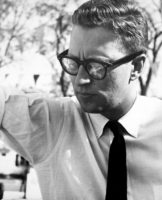The Serpentine Pavilion has become one of London’s leading summer attractions since launching in 2000. Last year’s cloud-like structure by Japanese architect Sou Fujimoto within the city’s Kensington Gardens was visited by almost 200,000 people. In March, Serpentine Galleries Director Julia Peyton-Jones and Co-Director Hans Ulrich Obrist announced their selection of Chilean architect Smiljan Radić to design the 2014 edition of the temporary construction. A 2008 Architectural Record Vanguard, the architect may not be as well-known as some of his pavilion-designer predecessors – which include Rem Koolhaas, Frank Gehry, Peter Zumthor, Alvaro Siza, and Toyo Ito – but, according to the curators, “Radić is a key protagonist of an amazing architectural explosion in Chile.”
Occupying a footprint of some 3,700 square feet, Radić’s semi-translucent, cylindrical structure was designed to resemble a shell, resting on large quarry stones. Its flexible, multi-purpose social space features a café. The Pavilion’s four-month tenure in the park began on June 26. RECORD spoke with Radić about the honor.
Previous architects of the Serpentine Pavilion have included a number of Pritzker Prize laureates. What does this mean to you?
It means I must be myself.
What is your concept for the design of this year's pavilion?
The pavilion is part of the history of small romantic constructions seen in parks or large gardens, the so-called follies, which were hugely popular from the end of the 16th century to the start of the 19th. In general, follies appear as ruins or worn away by time, displaying an extravagant, surprising, and often primitive nature. These characteristics artificially dissolve the temporal and physical limits of the constructions themselves with their natural surroundings. These formal mechanisms are taken literally by our pavilion, applying a contemporary architectural language.
The pavilion has many similarities to the restaurant you designed in Santiago, which also sits in a park-like setting and uses boulders as columns. Are there other aspects of the project you borrowed from earlier work? Are there aspects that are completely new to this project?
You're right. There are some obvious similarities with other projects, particularly with regard to some materials like stones that are unusual. The design for this pavilion is close to a model that I made some years ago, called the Castle of the Selfish Giant, based on the story by Oscar Wilde. I never thought to build this model, as it was somewhat theoretical. The Serpentine version features significant modifications that allow it to become a reality at such a big scale.
Why did you choose the sheath the pavilion in fiberglass as opposed to some other translucent material? Is this the first time you've worked with this material?
Yes, this is my first time working with fiberglass. That was the first reason to use it – to take a risk and learn a little more about something unknown to me. The original model for the Castle of the Selfish Giant used papier-mâché. When you manipulate fiberglass, it has very interesting tectonic qualities. It also has great structural strength even with minimum thicknesses, allowing you to generate a sense of fragility. The structural shell will feature fiberglass between 1/2-inch- and 5/8-inch-thick. A discontinuous translucency allows you to perceive the layers involved in its construction and the final texture betrays its textile origin.
When we spoke nearly six years ago, you mentioned that you were not eager to work outside of Chile. In fact, almost all of your work is in Chile. What have you learned having a project built in London?
This international opportunity is still an exception in my work. It was significant to my learning because there is an outstanding team of professionals behind the project. None of the pavilions constructed could occur without this team, because the design time is so short. Their management and construction of the project, together with the quality standards that the curators have been able to establish over the years, has made this a rare project for me that will not be repeated.
At this point, do you hope to do more work abroad?
Not really. The important fact is not working outside of Chile. Working abroad is relevant to the extent that one can learn new, significant things. If I travel 16 hours to do the same thing I do in Chile, I prefer to stay where I am.
You recently completed a renovation and expansion of the Chilean Museum of Pre-Colombian Art. Is that your biggest project to date? Have you begun to do more institutional work?
I am not really interested in very large-scale projects, and often I do not feel comfortable doing them. In Chile, projects up to 100,000 square feet can be constructed quickly and controlled by a small office. In December, we’ll start building a 172,000-square-foot facility for Vik vineyards, and the Regional Theater of the Bío Bío in central Chile begins construction next month. We’re currently working on a middle-class housing project in Santiago, and by year-end will start on a space for experimental performing arts in Santiago, named Proyecto Yungay. Two months ago, we won an international competition for the 518-foot-tall Telecommunications Tower in Santiago. We hope to develop the design for that within this year.
What is your ideal project?
I’d like to work in public space in the most classic sense of the concept.











Post a comment to this article
Report Abusive Comment